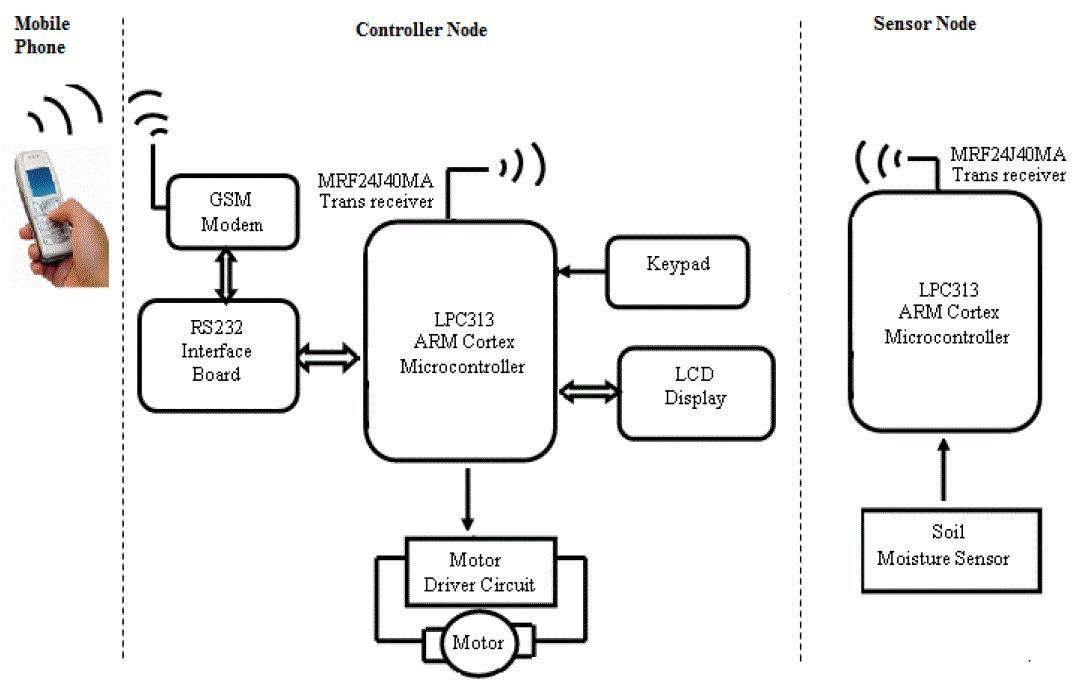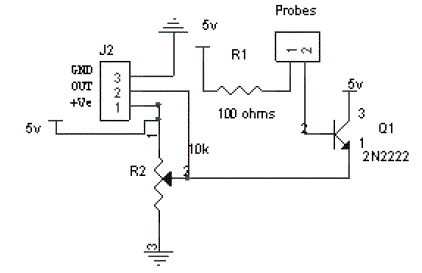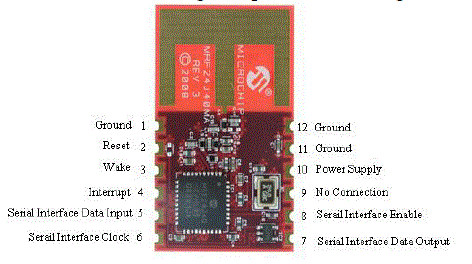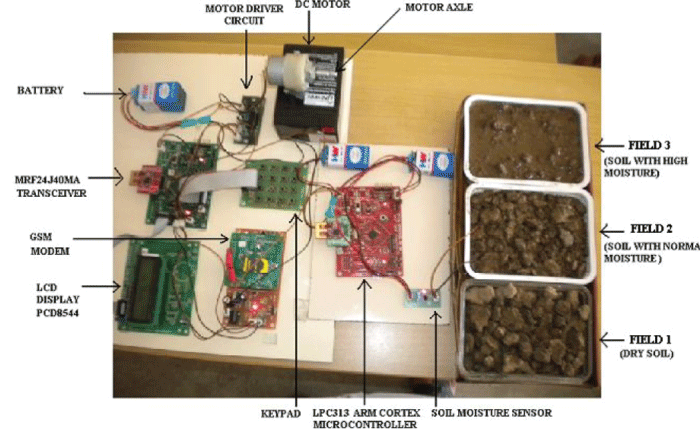Keywords
|
| Wireless sensor network (WSN), Global system for mobile communication (GSM), Short message service (SMS), Advances RISC machine (ARM), Liquid crystal display (LCD). |
INTRODUCTION
|
| Agriculture is major source of food production to the growing demand of human population. In agriculture, irrigation is an essential process that influences crop production. Generally farmers visit their agriculture fields periodically to check soil moisture level and based on requirement water is pumped by motors to irrigate respective fields. Farmer need to wait for certain period before switching off motor so that water is allowed to flow in sufficient quantity in respective fields. This irrigation method takes lot of time and effort particularly when a farmer need to irrigate multiple agriculture fields distributed in different geographical areas. Traditionally farmers will present in their fields to do irrigation process. But nowadays farmers need to manage their agriculture activity along with other occupations. |
| Automation in irrigation system makes farmers work much easier. Sensor based automated irrigation system provides promising solution to farmers where presence of farmer in field is not mandatory to perform irrigation process. Automated systems are electromechanically programmed for controlling mechanical devices like water pumping motor, water pipe valves, etc based on the feedback of sensor node placed in irrigation field. Many existing system use computers, data base technologies for monitoring and controlling irrigation activity [2], [3], [6]. But in real time farmers need cheap and simple user interface for controlling sensor based automated irrigation system. Nowadays mobile phone is the most common device used by famers. Therefore mobile phone is used in sensor based automated irrigation system [1], [4], [5], [14]. This helps farmers to control irrigation process easily from remote locations. |
| In this paper we present a prototype for automatic controlling and remote accessing of irrigation motor. Prototype includes sensor node, controller node and mobile phone. In sensor node, soil moisture sensor, wireless transceiver is integrated with ARM cortex microcontroller. In controller node, GSM module, wireless transceiver, keypad, LCD display and a motor is integrated with ARM cortex microcontroller. For experimentation we have abstracted three pots containing soil with different moisture level as irrigation fields. The soil moisture in each field is sensed by sensor node and the sensed data is sent to controller node. On receiving sensor value the controller node checks it with required soil moisture value. When soil moisture in a particular field is not up to required level then controller node switch on the motor to irrigate associated field and notification SMS is send to registered mobile phone. Mobile phone can also be used for requesting soil moisture information in irrigation field and commands can be sent as SMS to switch on/off the motor. Rest of this paper is organized as follows: Section 2 presents a literature study on sensor based irrigation systems, section 3 is proposed system, section 4 is system components, section 5 is experiment setup, section 6 is experimentation, and section 7 is conclusion. |
LITERATURE STUDY
|
| In this section we present a detailed study on sensor based automated irrigation systems. Constantinos et al [3] implemented a smart garden irrigation system using WSN. Authors abstract a regular home garden with three pots containing different plants with highly diverse watering needs. Soil humidity of the pot is monitored by sensor mote equipped with soil humidity sensor. Watering of the pot is controlled by mote-driven electro-valve. When the pot soil is too dry the sensor mote drives the electro-valve to start watering the pot. When the soil humidity returns to normal level the mote signals electro-valve to cut off water supply for that pot. Similarly Raul Morais et al [11] implemented a smart wireless sensor network irrigation system. The system uses LM50B temperature sensor, hybridCap relative humidity sensor, TSL230 solar radiation sensor, and dual-probe heat-capacity sensor for motoring irrigation field. Also Ragheid Atta et al [10] implemented a smart irrigation system for wheat cultivation in saudi arabia using wireless sensors network. The system performs well in maintaining the normal growth of plants while saving the amount of water used by around 25%. Tahar Boutraa et al [15] evaluated the effectiveness of automated irrigation system over manual irrigation system. The evaluation parameters are shoot, root, total fresh weight and dry weight of wheat crop. Both manual and automatically irrigated plants show no major difference in shoot growth and total fresh weight. However root growth and total dry weights are higher in automatically irrigated plants than those manually irrigated. Photosynthesis is the process by which plants make their food. The rates of photosynthesis were determined in both manually and automatically irrigated plants. The results showed that photosynthesis rates declined earlier in manually irrigated plants. |
| Mahir Durson and Semih Ozden [6] implemented automated drip irrigation system for watering dwarf cherry tree distributed in large geographical area. The system has 3 portable units: base station unit (BSU), valve unit (VU) and sensor unit (SU). SU senses soil moisture in distributed geographical areas and sends it to base station unit. BSU evaluates the data received from SU and decides the geographical area for irrigation. Manish Giri and Dnyaneshwar [7] proposed automated drip irrigation system using linear programming. Linear programming approach properly use available water resource to irrigate the field effectively in such a way to get maximum profit with lower cost. Sukhjit Singh and Neha Sharma [13] applied fuzzy algorithm in wireless sensor drip irrigation technique to control wastage of water. Compared to Nuppy algorithm, the fuzzy algorithm produces better average end to end delay and reliable water level information. Muhammad Umair and Usman [8] present artificial neural network (ANN) system for irrigation scheduling. ANN controller is compared with ON/OFF controller and the results shown that ON/OFF controller based system fails miserably because of its limitations. On the other hand ANN controller has inherent ability to adapt to the changing conditions unlike conventional methods. Prisilla et al [9] present a novel method for irrigating paddy fields using ANN. The system takes four input parameters like temperature, air humidity, wind speed and radiation to calculate required soil moisture using penman-monteith method. ANN controller compares calculated soil moisture with required soil moisture and if the soil moisture is not up to the required level then the ANN controller decides to open the associated electro-valve for irrigation. |
| Chavez et al. [2] implemented Single Board Computer (SBC) that interfaces with sensor network for recording measurements from irrigation fields. The SBC populates recorded sensor values in remote real time data base server and provides software applications to monitor and control the irrigation system through Internet. Ahmed et al. [1] developed an ultra low cost cell phone based remote control application for irrigation motor-pump. Rural areas in many states of India are plagued by frequent power cuts and abnormal voltage conditions. The developed system ensures that water is distributed to field whenever normal conditions exist. Information is exchanged in form of messages / miscalls between the system and user mobile phone. The system is based on AVR ATMega32 micro-controller and includes protection against single phasing, over-current, dry running and other desirable features. Similarly sumeetha et al.[14] provided a remote control application to control the irrigation motor using mobile phone. The system is developed using PIC16F877A microcontroller which integrates sensors, GSM and motor. The microcontroller controls the operation of motor based on the feedback of sensors. When the temperature decreases beyond normal or when voltage level is low or when there is no flow of water in the pipe due to insufficient water level in the well the motor gets off automatically and the problem is intimated to farmers through SMS. Mobile phone is used to control the motor using missed calls. Also Karthik Maddipatla et al. [5] developed a system that allows user to control agricultural motor via mobile phone. The system controls motor from remote location and eliminates the need of physical presence of farmer in field to operate agriculture motor. Also Jothipriya and saravanabava [4] presented a GSM based embedded system for the automation of drip irrigation. The developed system ensures that water is distributed to field by automatic switching on/off of main gate valves whenever a normal voltage condition exists. Information is exchanged in form of SMS between the system and the user mobile phone. The system is based on PIC18F452 micro-controller and Zigbee module. |
PROPOSED SYSTEM
|
| In this section we propose a prototype for automatic controlling and remote accessing of irrigation motor. The proposed system use mobile phone for controlling irrigation motor based on the feedback of soil moisture sensor. In most of the existing systems mobile phone is used to switch on/off the motor whenever a normal voltage condition exists. Figure 1 illustrates overview of the proposed system. The prototype includes: sensor node, controller node, and a mobile phone. In sensor node, soil moisture sensor and MRF24J40MA transceiver is integrated with LPC313 ARM cortex microcontroller. In controller node, GSM module, LCD display, keypad, MRF24J40MA transceiver and a motor is integrated with LPC313 ARM cortex microcontroller. |
| The sensor node can be deployed in irrigation fields for sensing local soil moisture and the sensed data is sent to controller node using MRF24J40MA transceiver. The controller node checks the soil moisture of irrigation field and if the soil moisture is not up to the required level then controller node switch on the motor to irrigate associated field and alert message is sent to registered mobile phone. Mobile phone can be used for sending request to get soil moisture of irrigation field and commands can be sent as SMS to switch on/off the motor. The controller node has a navigation keys to set the mode of operation and an LCD display to view sensor data. The system can operate in 3 modes: manual mode, auto mode and remote mode. In manual mode, system operations are controlled by key pad. In auto mode, system operation is based on the feedback of soil moisture sensor. In remote mode, system operation is controlled from remote location by sending SMS from registered mobile phone. |
SYSTEM COMPONENTS
|
Software Components
|
| • Embedded C |
| • Cortex-M3 peripheral device drivers |
| • Eclipse based LPC Xpresso IDE |
| • Cortex microcontroller software interface standard (CMSIS) |
Hardware Components
|
| LPC 313 ARM Cortex Microcontroller: The LPC1313 ARM Cortex-M3 microcontroller features high level of integration and low power consumption. The microcontroller supports In-System Programming (ISP) and In- Application Programming (IAP) via on-chip boot loader software. The peripheral complement of microcontroller includes 72 MHz CPU frequency, 32 Kb of flash memory, 8 Kb of data memory, USB device, on I2C-bus interface, UART, four general purpose timers, 42 general purpose I/O pins, programmable Watch Dog Timer (WDT) and integrated power management unit to minimize power consumption during sleep, deep-sleep, and deep power-down modes. |
| Soil Moisture Sensor: Soil moisture sensor includes a 2N2222 transistor, 10Kohm variable resistance pot, 100 ohm resistor and two soil probes as shown in Fig. 2. The soil probes consist of two thin copper wires each of 5cm length which can be immersed into the soil under test. The circuit gives a voltage output corresponding to the conductivity of soil. The soil between the probes acts as a variable resistance whose value depends upon moisture content in soil. The transistor is being used as a common emitter amplifier. To keep transistor in active region, the base emitter junction is forward-biased and collector-base junction is reverse-biased (active region of common-emitter configuration can be employed for voltage or current amplification). By using 100 ohm resistance and variable resistance the base-emitter junction is brought to forward-bias condition. The resistance across soil probes can vary from infinity (for completely dry soil) to a very little resistance (for 100% moisture in soil). |
| This variation in resistance across the probes (RS) leads to variation in forward-bias voltage which leads to corresponding variation in input base current (Ib). For common emitter configuration c b I =β.I , where β is current amplification factor. Hence a small variation in base current leads to a large variation in emitter current and hence the emitter voltage is taken as the voltage output of sensor [12]. |
| MRF24J40MA Transceiver: The MRF24J40 is an IEEE 802.15 standard compliant 2.4 GHz RF transceiver. Figure 3 shows a simplified block diagram of a MRF24J40 transceiver. It integrates internal voltage regulator, matching circuitry and Printed Circuit Board (PCB) antenna. The MRF24J40MA module is a short range, low power, and low data rate wireless technology used for connecting sensor nodes with controller node. It operates on the 2.4 GHz, Industrial, Scientific and Medical (ISM) band and transmission range is up to 400 feet. Highest achievable data rate is 250Kbps. |
| GSM Modem: GSM wireless modem works with GSM wireless network for transferring data between mobile phone and controller node. Like GSM mobile phone, a GSM modem requires a subscriber identity module (SIM) card to operate. GSM is a circuit-switched system operates in frequency band of 933 - 960 MHz (for uplink) and 890 - 915 MHz (for downlink). GSM uses Gaussian Minimum Shift Keying (GMSK) as modulation method and Time Division Multiple Access (TDMA) technique for transmitting signals. It has an ability to carry 64 kbps to 120 Mbps of data. |
| Keypad: A keypad with 16 keys is used for controlling the system. Keypad is used for entering passwords, setting the mode of operation, requesting sensor data and switching on/off motor. The details are given as follows |
| Key (1 to 10): password generation |
| Key 11: manual mode |
| Key 12: auto mode |
| Key 13: remote mode |
| Key 14: request sensor data |
| Key 15: motor on |
| Key 16: motor off |
| Other Hardware Components: PCD8544 a low power graphical LCD is used to display sensor values. LCD has 48 rows, 84 column output. Motor driver circuit is simply a switch for motor and 9 V batteries are used for power supply. |
EXPERIMENTAL SETUP
|
| We have abstracted three pots containing soil with different moisture level as irrigation fields. Field 1 contains dry soil, field 2 contains soil with normal moisture and field 3 contains soil with high moisture. Soil moisture in each field is measured by a sensor node equipped with a soil moisture sensor. Two probes of soil moisture sensor are inserted into soil to measure soil moisture in the field. Figure 4 illustrate the experimental setup of the prototype. |
| Let us assume Mδ is the required soil moisture value in each field. Now M1 < Mδ, M2 < Mδ and M3 > Mδ. Where M1 is the soil moisture value in field 1; M2 is the soil moisture value in field 2 and M3 is the soil moisture value in field 3. |
EXPERIMENTATION
|
| The system is experimented in following cases. |
| Case 1: sensor node deployed in field 1 and controller node is set to auto mode. |
| Case 2: sensor node deployed in field 1 and controller node is set to remote mode. |
| Case 3: sensor node deployed in field 2 and controller node is set to auto mode. |
| Case 4: sensor node deployed in field 2 and controller node is set to remote mode. |
| Case 5: sensor node deployed in field 3 and controller node is set to auto mode. |
| Case 6: sensor node deployed in field 3 and controller node is set to remote mode. |
| In case 1, sensor node deployed in field 1 senses soil moisture M1 and sends it to controller node. Controller node compares M1 with Mδ. Since M1 < Mδ the motor is switched on and notification SMS is sent to registered mobile phone. Now the soil moisture in field 1 increased. After certain time, sensor node in field 1 again senses the soil moisture and sends it to controller node for checking. Now since M1 > Mδ the motor is switched off and notification SMS is sent to registered mobile phone. In case 2, SMS is send from registered mobile phone to controller node requesting for soil moisture value in field 1. On receiving request SMS the controller node get soil moisture M1 from field 1 and compares it with Mδ. Since M1 < Mδ controller node sends alert SMS to registered mobile phone. On receiving reply for alert SMS the motor is switched on. Now the soil moisture in field 1 increased. After certain time, sensor node in field 1 senses the soil moisture and sends it to controller node for checking. Now since M1 > Mδ alert SMS is sent to registered mobile phone. On receiving reply for alert SMS the motor is switched off. |
| In case 3, sensor node deployed in field 2 senses soil moisture M2 and sends it to controller node. Controller node compares M2 with Mδ. Since M2 < Mδ the motor is switched on and notification SMS is sent to registered mobile phone. Now the soil moisture in field 2 increased. After certain time, sensor node in field 2 senses the soil moisture and sends it to controller node for checking. Now since M2 > Mδ the motor is switched off and notification SMS is sent to registered mobile phone. In case 4, SMS is send from registered mobile phone to controller node requesting for soil moisture in field 2. On receiving request SMS the controller node get soil moisture M2 from field 2 and compares it with Mδ. Since M2 < Mδ, controller sends alert SMS to registered mobile phone. On receiving reply for alert SMS the motor is switched on. Now the soil moisture in field 2 increases. After certain time, sensor node in field 2 senses the soil moisture and sends it to controller node for checking. Now since M2 > Mδ the motor is switched off and notification SMS is sent to registered mobile phone. |
| In case 5, sensor node deployed in field 3 senses soil moisture M3 and sends it to controller node. Controller node compares M3 with Mδ. Since M3 >Mδ the motor will not be switched on but notification SMS will be send to registered mobile phone. After certain time period, soil moisture in field 3 decreases. Now the sensor node in field 3 senses the soil moisture and sends it to controller node for checking. Now since M3 < Mδ the motor is switched off and notification SMS is sent to registered mobile phone. In case 6, SMS is send from registered mobile phone to controller node requesting for soil moisture in field 3. On receiving request SMS the controller node get soil moisture M3 from field 3 and compares it with Mδ. Since M3 >Mδ the motor will not be switched on but notification SMS will be send to registered mobile phone. After certain time period, soil moisture in field 3 decreases. Now the sensor node in field 3 senses the soil moisture and sends it to controller node for checking. Now since M3 < Mδ the motor is switched off and notification SMS is sent to registered mobile phone. |
CONCLUSION
|
| In this paper we present a prototype for automatic controlling and remote accessing of irrigation motor. Prototype includes sensor node, controller node and mobile phone. The sensor node is deployed in irrigation field for sensing soil moisture value and the sensed data is sent to controller node. On receiving sensor value the controller node checks it with required soil moisture value. When soil moisture in irrigation field is not up to the required level then the motor is switched on to irrigate associated agriculture field and alert message is send to registered mobile phone. Mobile phone is used for sending request SMS to get soil moisture value in irrigation field and commands can be sent as SMS to switch on/off the irrigation motor. Prototype is experimented by abstraction three pots containing soil with different moisture level as irrigation fields. The experimental results show that the prototype is capable for automatic controlling and remote accessing of irrigation motor based on the feedback of soil moisture sensor. The prototype can facilitate farmer in monitoring and controlling irrigation activity from remote location. |
ACKNOWLEDGMENT
|
| We take this opportunity to express our deepest gratitude to the management and the principal of Aaruadai Veedu Institute of Technology (AVIT) for their support and encouragement in developing this prototype. We also appreciate all those who have helped us directly or indirectly towards the successful completion of this paper. |
| |
Figures at a glance
|
 |
 |
 |
 |
| Figure 1 |
Figure 2 |
Figure 3 |
Figure 4 |
|
| |
References
|
- Ahmed V, Ladhake S.A, “Design of Ultra Low Cost Cell Phone Based Embedded System for Irrigation”, Proceedings of the International Conference on Machine Vision and Human-Machine Interface (MVHI), pp. 718-721, 2010.
- Chavez Jose L, Francis J, Pierce, Todd Elliot., Robert G Evans, “A Remote Irrigation Monitoring and Control System (RIMCS) for Continuous Move Systems Part A: Description and Development”, Precision Agriculture, Vol. 11, pp.1-10, 2009.
- Constantinous Marios, Sotiris Nikoletseas, and Georgios Constantinos, “A Smart System for Garden Watering using Wireless Sensor Networks”, Proceedings of the 9th ACM International Symposium on Mobility Management and Wireless Access, pp. 153-158, 2011.
- Jyothipriya.A.N, Dr.T.P.Saravanabava, “Design of Embedded Systems for Drip Irrigation Automation”, International Journal of Engineering Science Invention, Vol. 2, Issue 4, pp. 34-37, 2013.
- Karthik Maddipatla, Thentu Sravani, Thota Rajesh, R.S.V. Mani Krishna, J. Avinash, “Remote Access to Agricultural Motor Through the Usage of GSM and SMS Technologies”, Advances in Computer Science and its Applications (ACSA),Vol. 1, No. 3, pp.211-214, 2012.
- Mahir Dursun and Semih Ozden, “A Wireless Application of Drip Irrigation Automation Supported by Soil Moisture Sensors”, Scientific Research and Essays, Vol. 6(7), pp. 1573-1582, 2011.
- Manish Giri and Dnyaneshwar Natha Wavhal, “Automated Intelligent Wireless Drip Irrigation Using Linear Programming ”, Proceedings of the Special Interest Group on Management of Data Record, International Journal of Advanced Research in Computer Engineering &Technology, Vol. 2, Issue 1, 2013.
- Muhammad Umair S and Usman R, “Automation of Irrigation System Using ANN based Controller”, International Journal of Electrical & Computer Sciences, Vol. 10, No. 2, pp. 45-51, 2010.
- Prisilla L, Simon Vasantha Rooban, and Dr. L. Arockiam, “A Novel Method for Water irrigation System for Paddy Fields using ANN”, International Journal of Computer Science and Network, Vol. 1, Issue 2, 2012.
- Ragheid Atta, Tahar Boutraa, and Abdellah Akhkha , “Smart Irrigation System for Wheat in Saudi Arabia using Wireless Sensors Network Technology”, International Journal of Water Resources and Arid Environments, Vol. 1, pp. 478-482, 2011.
- Raul Morais, A Valente, and C Serodi, “A Wireless Sensor Network for Smart Irrigation and Environmental Monitoring: A Position Article”, EFITA/WCCA2005, pp.845-850, 2005.
- Sanyam Agarwal, Arvind Gautam, Pankaj Singh and Rohit Sharma, “A BJT Based Soil Moisture Sensor for Irrigation Monitoring”, Journal of Pure and Applied Science & Technology, Vol. 2(1), pp. 116-123, 2012.
- Sukhjit Singh and Neha Sharma, “Research Paper on Drip Irrigation Management using wireless Sensors”, International Journal of Computer Networks and Wireless Communications, Vol. 2, No. 4, pp. 461-464, 2012.
- Sumeetha S and Sharmila D, “Embedded Based Remote Control Application using Mobile Phone in Irrigation”, International Journal of Power Control Signal and Computation, Vol. 3, No. 1, pp. 76-79, 2012.
- Tahar Boutraa, Abdellah Akhkha, Abdulkhaliq Alshuaibi, and Ragheid Atta, “Evaluation of the Effectiveness of an Automated Irrigation system using Wheat Crops”, Agriculture and Biology Journal of Nort America, Vol. 2, pp. 80-88, 2011.
|